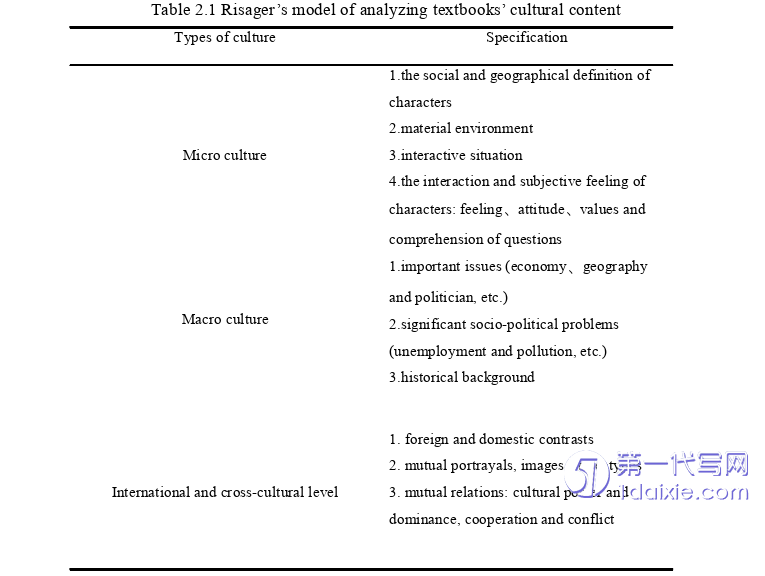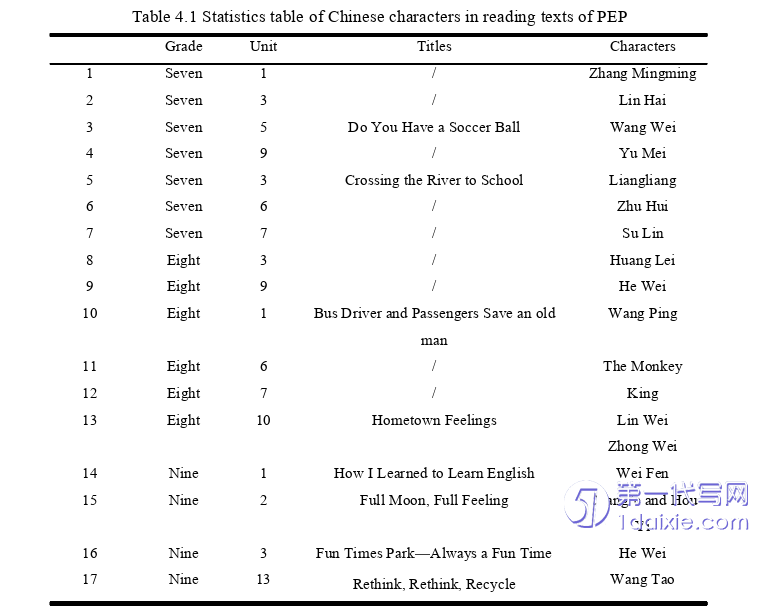本文是一篇英语论文,本研究重点聚焦于两版英语教材中的中国文化内容的研究,以提高教师对教材中中国文化的教学和学生对教材中的学习意识。
Chapter One Introduction
1.1 Research Background

With the development of globalization and technology,the internationalcommunications are becoming more and more frequent,and the interaction ofdifferent countries and languages is becoming deeper and deeper.As the carrier andtransmission medium of culture,language is the external manifestation of culture.Language and culture are interdependent,and influence each other and developtogether.Therefore,learning a language is learning the culture behind the language.The importance of learning culture is attached to language learning.EnglishCurriculum Standards for compulsory Education(2022 Edition)issued by theMinistry of Education puts forward that the goal of language learning is to cultivatestudents’core literacy,including language competence,learning ability,thinkingcapacity and cultural awareness.As one of the core literacy,cultural awarenessemphasizes that students need to learn cultural differences and respect differentcultures.At the same time,students also need to think highly of the learning of nativeculture.However,in the past,traditional English classroom attaches more importanceto foreign cultures,and ignore the learning of cultures of mother tongue.ManyEnglish learners are able to use English to introduce foreign cultures perfectly,whileit’s hard for most of them to use English to talk about the native cultures fluently.This phenomenon is called Chinese Culture Aphasia which is proposed by ProfessorCongcong.(Cong,2000)While the importance of mother tongue culture in targetlanguage learning has been widely noticed by linguists at home and abroad,which hasopened up a new field for the development of second language acquisition theory.
1.2 Research Purposes
Textbooks are the main tool for teachers to impart cultural knowledge,and alsoan important resource for students to learn cultural knowledge.This thesis hopes toachieve the following objectives.
Firstly,by classifying the Chinese cultural content in the PEP edition of thejunior high school English textbook and the Shanghai Oxford edition of the juniorhigh school English textbook,and comparing the representation methods of theChinese cultural content in the two editions of the textbook,we can have a goodunderstanding of the distribution of Chinese cultural content in the two editions of thetextbook.
Secondly,by comparing the representation methods of the two editions oftextbooks and through data statistics and comparative analysis,we can sum up theshortcomings and merits of the two editions of textbooks in the representation ofChinese cultural content,and provide teachers with information as well as provideguidance on cultural teaching at schools.
Chapter Two Literature Review
2.1 Key Concepts
In this section,some key terms are introduced.It mainly talks about the termswhich are relevant and helpful to understand the whole thesis.
2.1.1 Culture
There is no fixed definition of culture,and scholars from different fields havedefined it from different aspects.Therefore,there are hundreds of definitions aboutculture.Among them,the father of British anthropology,Taylor(1871)put forwardthe first academic definition of culture in his book Primitive Culture.He believed thatthe so-called culture or civilization includes knowledge,belief,art and a combinationof morals,laws,customs and any other abilities and habits acquired by individuals asmembers of society.Furthermore,Malinowski,another famous British culturalanthropologist,believes that culture refers to the same traditional objects,goods,technology,ideas,habits and values,and includes social organization.From thescholars,we can know that the connotation of culture has not yet formed a unifieddefinition.For the purpose of research,the concept of culture in this papereducationally adopts the interpretation of English Curriculum Standards forCompulsory Education(2022 edition)on culture,that is,in foreign language teaching,culture refers to the history and geography,local conditions and customs,traditionalcustoms,lifestyle,norms of behavior,literature and art,values and so on.And for thereason that this research studies the mother tongue culture in the Chinese textbooks,itis necessary to talk about the term mother tongue culture.
2.2 Studies on Textbook Evaluation at Home and Abroad
In western countries,some foreign scholars have achieved a lot of success inteaching material evaluation researches.The analysis of textbooks abroad began in the1960s.Some scholars began to conduct analytical work for teaching materials.Theyheld the view that it is difficult to become excellent teachers even if teachers haveexcellent textbooks,and even excellent teachers need to know how to make full use oftextbooks.Therefore,it is necessary to analyze and evaluate the teaching materials inorder to improve the teaching effect and help teachers better use textbooks.
Scholars in European and American countries have been exploring how toanalyze textbooks since the mid-19th century and have begun theoretical research ontextbook evaluation in the early 20th century.Their theoretical research includes theconcept,scope,content,function,subject,process,methods,and principles ofevaluation.By the late 1980s and early 1990s,theoretical research on the evaluationof English textbooks in European and American countries had become increasinglymature,and a large number of influential scholars and research results had emerged.Among them,their most important research achievement is the introduction ofevaluation methods and evaluation forms for English textbooks.
Chapter Three Research Methodology .......................... 29
3.1 Research Questions ...................... 29
3.2 Research Objects ............................. 29
3.3 Research Methods ............................. 30
Chapter Four Results and Discussions ............................. 35
4.1 The Comparative Analysis of Micro Chinese Culture in the Two Editions of theTextbook............................. 35
4.1.1 The comparison of gender of Chinese characters ...................... 37
4.1.2 The comparison of age of Chinese characters ........................... 38
Chapter Five Conclusion ................................ 58
5.1Major Findings ...................................... 58
5.2 Pedagogical Implications .................................. 60
Chapter Four Results and Discussions
4.1 The Comparative Analysis of Micro Chinese Culture in the TwoEditions of the Textbook
The lives and activities of the characters in the textbooks directly reflect thecultures they represent,so the lives and activities of Chinese characters in thetextbooks also reflect Chinese culture to some extent.Since there is often more thanone character in a textbook,researchers using Risager’s(1991)framework foranalyzing characters in textbooks have focused on the main characters in the readingpassages of both editions.According to the statistics,there are 17 reading texts in PEPwhich the main characters are Chinese or the texts include Chinese,as shown in Table4.1,while there are 12 texts in Oxford English in which the main characters includeChinese,as shown in Table 4.2.In this study,we will analyze the age,gender,andoccupation of the Chinese characters in the reading texts of the two editions.

Chapter Five Conclusion
5.1 Major Findings
In this section,the findings of a comparative analysis of the Chinese culturecontent of both PEP and Oxford English textbooks in three dimensions,microChinese culture and macro Chinese culture,as well as the explicit and implicitpresentation will be presented.In response to the statistical analysis,the mainconclusions of this study are as follows.
(1)Both editions of the textbook present a certain and reasonable proportion andof Chinese culture.
The two editions of textbook present a variety of Chinese culture,includingtraditional and contemporary Chinese culture,such as the introduction to traditional festivals and historical stories and so on.From the contents,both two editions oftextbooks present reasonable amount and kinds of Chinese culture.But from theperspective of richness,both two editions are not enough.
(2)In terms of micro Chinese culture,the two editions of the textbook Chinesecharacters have their own age focus,gender imbalance,and differences in the types ofoccupations.
The ages of the Chinese characters in both editions of the textbook have theirown focus,but each has its own strengths.The Chinese characters in the textbooks aresimilar in age to middle school students,which makes it easier for them to get closerto them and stimulate their interest in learning,while the selection of historical figureshelps students to better understand Chinese history.
reference(omitted)
